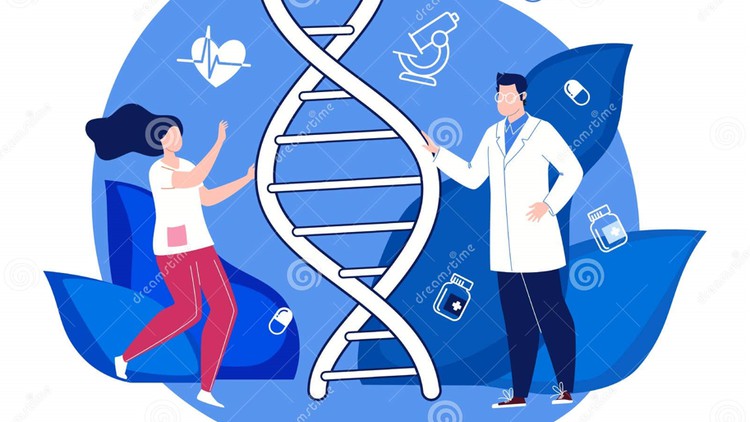Basics of Bioinformatics
- Description
- Curriculum
- FAQ
- Reviews
- Grade

Welcome to the “Basics of Bioinformatics” course, a comprehensive exploration of the interdisciplinary field that bridges biology and computational science. This course equips learners with essential knowledge and skills to navigate the vast landscape of biological data through the lens of bioinformatics.
Throughout this program, participants will delve into key areas such as biological databases, bioinformatics tools, and software, gaining hands-on experience in data retrieval and analysis. The course places a strong emphasis on sequence analysis, covering DNA, RNA, and protein sequences, along with alignment techniques and their diverse applications. Structural bioinformatics is a focal point, where learners will explore protein structure prediction, molecular docking, and drug design.
Genomics, transcriptomics, and proteomics form integral components of this course, providing a deep dive into the technologies and analyses underpinning large-scale biological datasets. Practical skills in utilizing bioinformatics tools for drug discovery and understanding systems biology will be honed. Ethical considerations in bioinformatics research, legal implications, and responsible data handling practices are also thoroughly examined.
By the course’s conclusion, learners will have a solid grasp of bioinformatics fundamentals, the ability to analyze biological sequences and structures, proficiency in omics technologies, and a nuanced understanding of ethical and legal aspects in the field. Whether you are a student, researcher, or professional in the biological sciences, this course empowers you to leverage bioinformatics tools for advanced data-driven insights in your research and contribute to the evolving landscape of modern biology.
-
1Introduction to Bioinformatics
1.1 Definition and Scope of Bioinformatics
1.2 Historical Evolution of Bioinformatics
1.3 Importance in Modern Biological Research
1.4 Interdisciplinary Nature of Bioinformatics
-
2Biological Databases and Data Retrieval
2.1 Types of Biological Databases
2.2 Structure and Organization of Databases
2.3 Data Retrieval Techniques
2.4 Data Quality and Integrity in Bioinformatics
-
3Bioinformatics Tools and Software
3.1 Overview of Bioinformatics Tools
3.2 Commonly Used Bioinformatics Software
3.3 Online Resources and Web Servers
3.4 Hands-on Practice with Bioinformatics Tools
-
4Sequence Analysis
4.1 DNA, RNA, and Protein Sequences
4.2 Sequence Alignment Techniques
4.3 Pairwise and Multiple Sequence Alignment
4.4 Applications of Sequence Analysis in Bioinformatics
-
5Structural Bioinformatics
5.1 Introduction to Protein Structure
5.2 Prediction of Protein Structure
5.3 Structural Databases and Resources
5.4 Molecular Docking and Drug Design
-
6Genomics and Functional Genomics
6.1 Genomic Sequencing Technologies
6.2 Genome Annotation and Analysis
6.3 Comparative Genomics
6.4 Functional Genomics and Systems Biology
-
7Transcriptomics and Expression Analysis
7.1 Basics of Transcriptomics
7.2 RNA-Seq and Microarray Technologies
7.3 Differential Gene Expression Analysis
7.4 Functional Interpretation of Expression Data
-
8Proteomics and Metabolomics
8.1 Principles of Proteomics
8.2 Mass Spectrometry in Proteomics
8.3 Metabolomics Techniques
8.4 Integration of Omics Data
-
9Bioinformatics in Drug Discovery
9.1 Target Identification and Validation
9.2 Virtual Screening and Docking Studies
9.3 Pharmacophore Modeling
9.4 Challenges and Opportunities in Drug Discovery
-
10Systems Biology
10.1 Concepts of Systems Biology
10.2 Modeling Biological Systems
10.3 Network Biology
10.4 Applications of Systems Biology in Research
-
11Ethical and Legal Issues in Bioinformatics
11.1 Privacy and Security Concerns
11.2 Intellectual Property and Data Sharing
11.3 Ethical Practices in Bioinformatics Research
11.4 Regulations and Guidelines
-
12Future Trends in Bioinformatics
12.1 Emerging Technologies in Bioinformatics
12.2 Integration of Artificial Intelligence in Bioinformatics
12.3 Personalized Medicine and Bioinformatics
12.4 Career Paths and Opportunities in Bioinformatics








